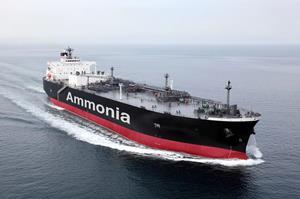The first day of The Motorship Propulsion and Future Fuels Conference 2019 brought together ship owners, ship operators and industry leaders to discuss the challenge of decarbonisation and strategies to meet existing and future IMO targets.
Digitalisation in the industry, the upcoming introduction of the IMO 2020 Global Sulphur Cap and an extended discussion about hydrogen as a future fuel complemented a high-level ship owners’ discussion of decarbonisation in a busy first day at the Motorship Propulsion and Future Fuels Conference 2019 in Hamburg yesterday.
First day Chairman, Reinhard Lüken, CEO, German Shipbuilding and Ocean Industries Association (VSM) opened the conference and set the tone for the day’s discussions. He identified commercial challenges such as overcapacity and poor margins as greater barriers to building the vessels needed to meet the IMO’s targets than technical obstacles.
Roger Strevens of Wallenius Wilhelmsen noted that while the shipping fuel market represented a USD100bn/year opportunity, and shipping itself was an indispensable industry, industry participants could expect to see winners and losers emerge as capex and opex costs were likely to rise, while services may change.
The shipowner panel included suggestions ranging from concept designs, such as NYK Line and Elomatic’s hydrogen-fuelled solid oxide fuel cell powered, flapping foil-propelled 2050 vessel, through to practical solutions, such as cold-ironing and port call optimisation, proposed by Wolfram Guntermann of Hapag Lloyd.
Tom Strang, SVP, Maritime Affairs of Carnival, identified LNG as an intermediate fuel that could meet IMO targets. Mr Strang added ZEV cruise vessel would be needed to meet IMO 2050 targets. “Given cruise vessel newbuild lead times, we need to begin design work on ZEV cruise vessel today for them to enter service in the 2030s,” Strang said.
The second session focused on hydrogen as a future fuel and included a range of different perspectives. Sebastiaan Bleunanus, General Manager of Research coordination at Wartsila, concurred with speakers in the previous session, and identified synthetic methane as the optimum hydrogen carrier.
Sami Kanerva, Senior Principal Engineer of ABB Marine & Ports noted that directly consuming hydrogen in PEM fuel cells was the most convenient approach if the conversion costs incurred in transforming hydrogen into synthetic fuels were taken into account.
The session also included a number of experienced safety and regulatory experts, like Olav Hansen of Lloyd’s Register and Kolbjorn Berge of the NMA who discussed safety issues around compressed and liquid hydrogen containment vessels, and the regulatory environment, respectively.
The final session of the day confronted delegates with a choice between digitalisation and IMO 2020 streams. The wide range of operational benefits offered by digitalisation was reflected in presentations from Markus Hoffman of Alfa Laval, Inbar van den Burg of Shell Marine and Steve Walker of ExxonMobil while Patrick Muller of Siemens shared details of Siemens’ new Pre-Integrated Internet of Things (IoT) offering.
The second stream included Poul Woodall of DFDS sharing operational experience of a decade of exhaust gas cleaning system (scrubber) use, while Eddie Fish of ExxonMobil and Tracy Wardell of Intertek ShipCare approached the impact of the IMO 2020 global sulphur cap from a fuel supplier and fuel testing service perspective.
Day two of the conference is in progress now and the discussions continue on Ammonia, LNG, alternative fuels and batteries.
Make sure you take a look at @Motorship to keep up to date with what is happening at this year’s conference.










